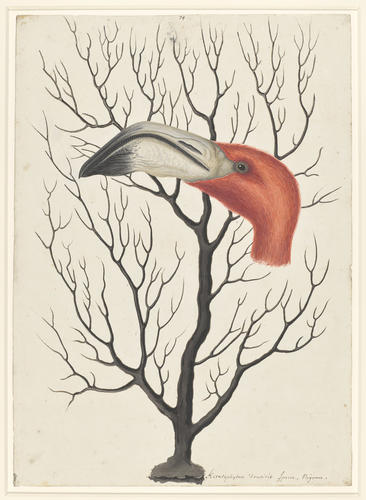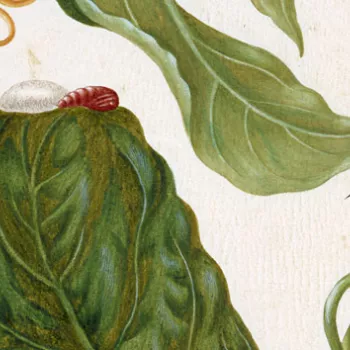The Bill of the Flamingo in its full Dimensions c.1722-6
Watercolour and bodycolour over pen and ink and traces of pencil | 37.9 x 27.1 cm (sheet of paper) | RCIN 925909
-
A watercolour of the head and large grey bill of an American flamingo (Phoenicopterus ruber Linnaeus), profile left. Behind is a spray of bent sea-rod (Plexaura flexuosa Lamouroux). Inscribed in ink at bottom right: 'Keratophyton fruticis specie, nigrum'.
Mark Catesby was born in Suffolk and was interested in natural history from an early age. In 1712, he travelled to the east coast of America with his sister Elizabeth, who had married a doctor who practised in Williamsburg, Virginia. Catesby spent seven years in Virginia collecting specimens and seeds for London buyers before returning to Britain. In London his drawings of birds and plants met with praise and a group of benefactors paid for his travel to Carolina in 1722. There, he made numerous drawings of the flora and fauna, working hard to ensure that his depictions were as helpful for an understanding of their subjects as possible. On his return to Britain, his drawings were reproduced in The Natural History of Carolina, Florida and the Bahama Islands, which appeared in a series of volumes between 1729 and 1747. The first volume was dedicated to Queen Caroline, the second to Augusta, Princess of Wales. The original drawings from the volumes, which had been in the possession of Catesby’s widow until her death, were purchased by George III from the London bookseller Thomas Cadell in 1768.
When Catesby visited the Bahamas in 1725 he would have seen bent sea-rod (a soft coral) and flocks of flamingo. He rarely depicted an isolated part of a creature and the structure of the flamingo's beak clearly interested him. He recorded that ‘Nature has provided the edges of their Bill with a Sieve, or Teeth, like those of a fine comb’, which allows flamingos to filter their food out of the mud.
The watercolour was used as the basis for plate 74 in the first volume of the Natural History.
For identification of the species depicted see James L. Reveal, 'Identification of the plants and animals illustrated by Mark Catesby for his Natural History of Carolina, Florida, and the Bahama Islands' in Phytoneuron 2013 and revised online version.
Provenance
Thomas Cadell; from whom bought by George III, 1768
-
Creator(s)
Acquirer(s)
-
Medium and techniques
Watercolour and bodycolour over pen and ink and traces of pencil
Measurements
37.9 x 27.1 cm (sheet of paper)
Other number(s)
RL 25909Alternative title(s)
Caput Phoenicopteri Naturalis Magnitudinis









